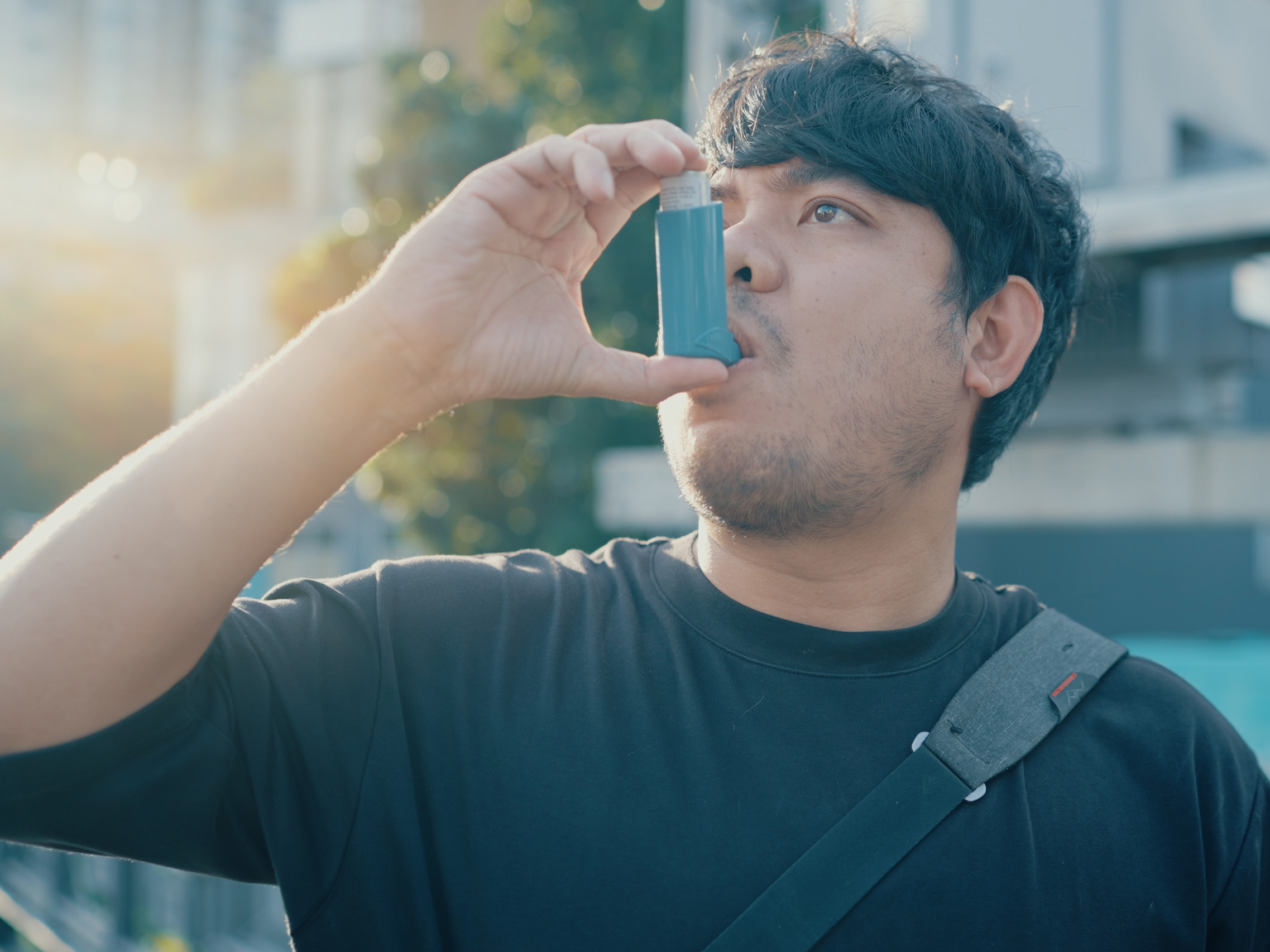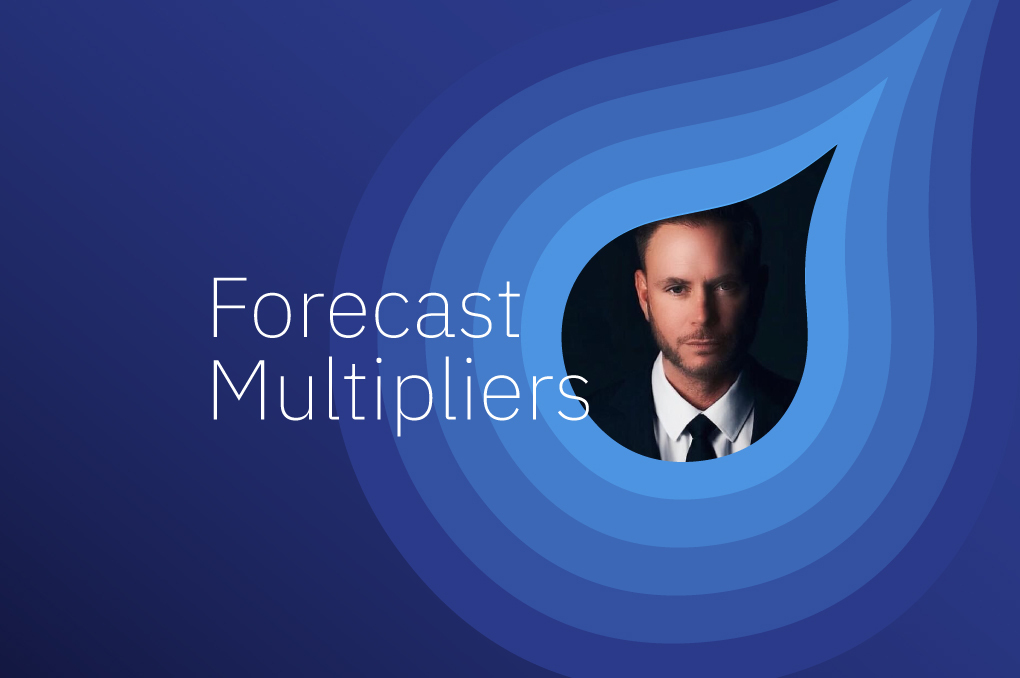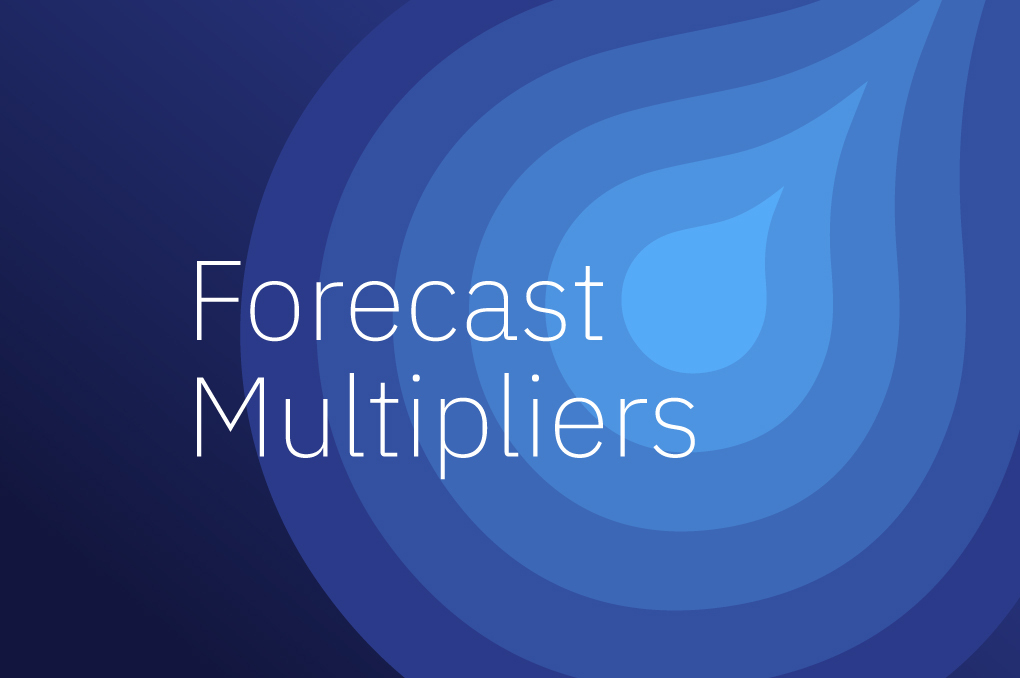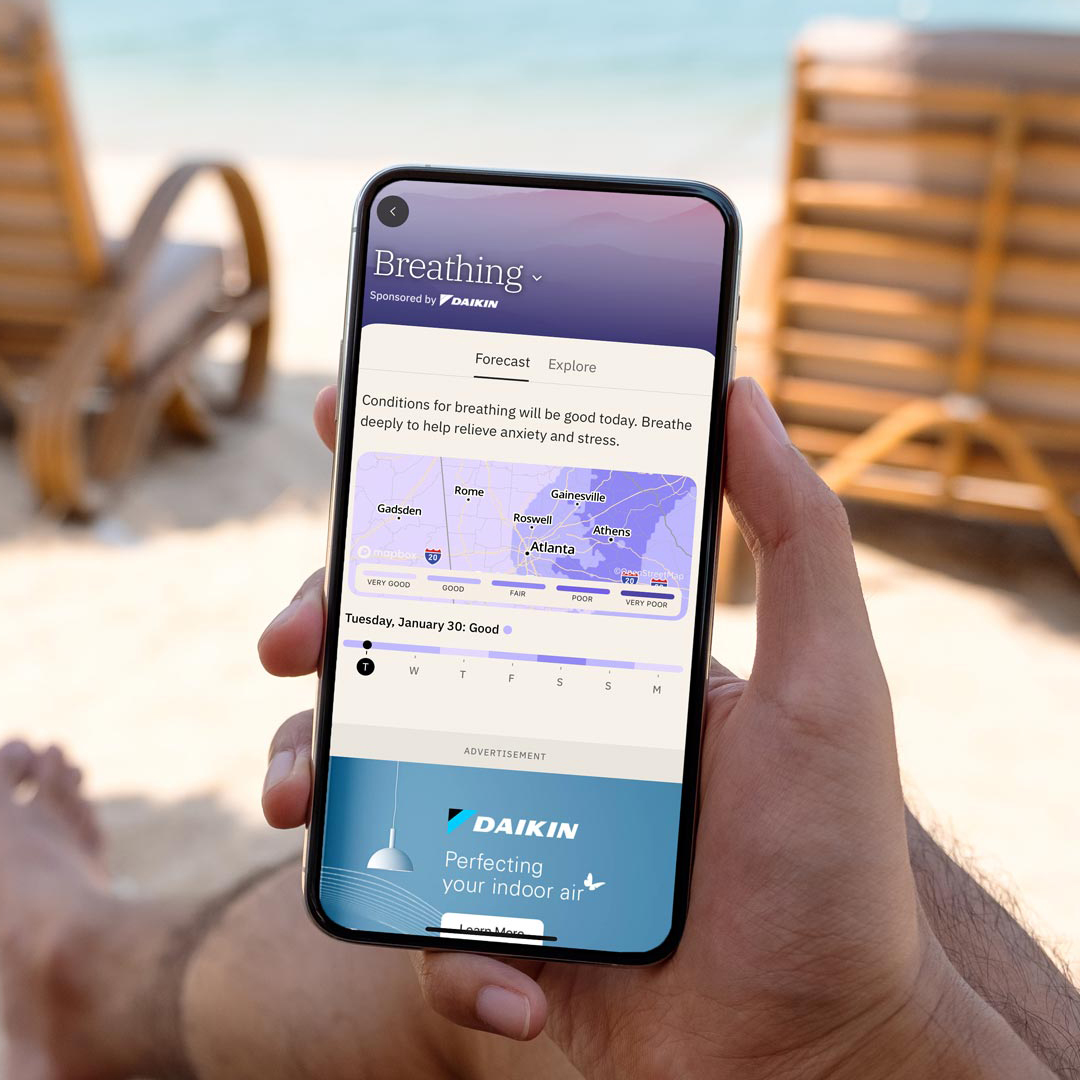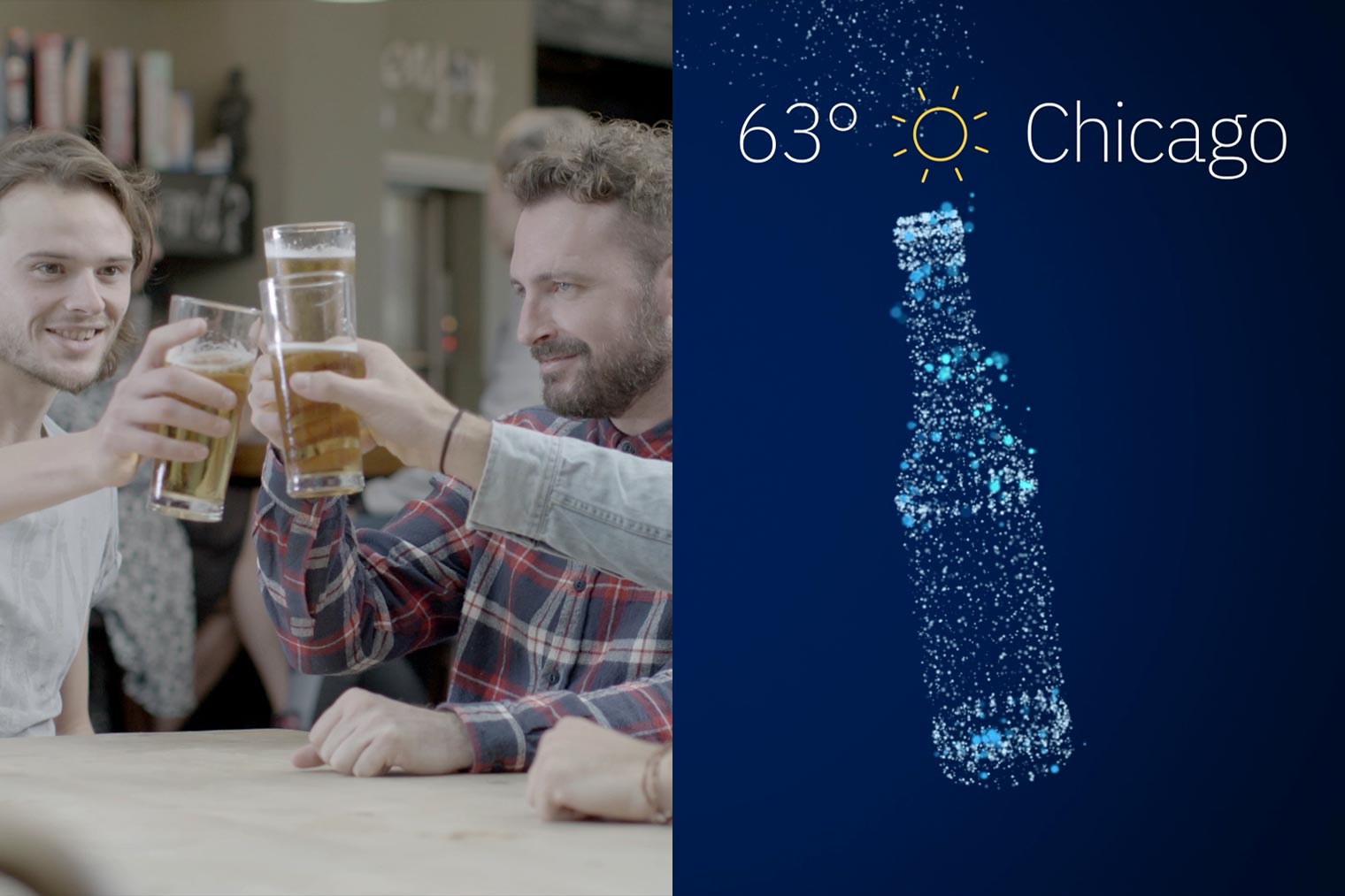Weather intelligence for the future: Crafting a strategic enterprise approach to changing environmental conditions
Continue readingAs the wellness movement swept through society four years ago, it sparked discussions far beyond the headlines. Everyone from investors to business leaders to consumers debated whether this was just a fleeting trend, or the dawn of a new cultural era that would shape consumer behavior for years.
That question has long since been answered. The $1.8 trillion global wellness market1 is showing no signs of slowing down. Rather, its growth is not only reenergizing consumer focus on health, it’s reenergizing competition between brands who are trying to solidify their spot in shopping carts of health-minded people across generations.
A growing wellness market also means growing expectations. According to a recent report by Accenture, nearly two-thirds (64%) of consumers wish that companies would respond faster with new offerings to meet their changing needs. As health brands and businesses in a competitive space face an ongoing challenge to balance personalization with privacy, finding the right contextual data, strategy, and message to meet in-the-moment needs is a top priority.
Easier said than done. But, one of the most overlooked — yet impactful — forces influencing people’s health is the weather. And that signal is becoming one of the biggest strategic opportunities for health marketers today.
The weather-to-wellness connection
A strong advantage for health marketers, weather already plays such a significant role as people manage their daily health and wellness choices. Research shows 76% of health-minded consumers use weather forecasts and information to manage their health condition(s) — a 33% increase since 20202 — weather drives actions like making plans (or changing them), optimizing the right medicine dosages, and of course, purchases we make. With seasonal weather norms shifting, people need to be constantly monitoring those changes so they can take steps to prevent or minimize adverse symptoms while maximizing the potential of living well.
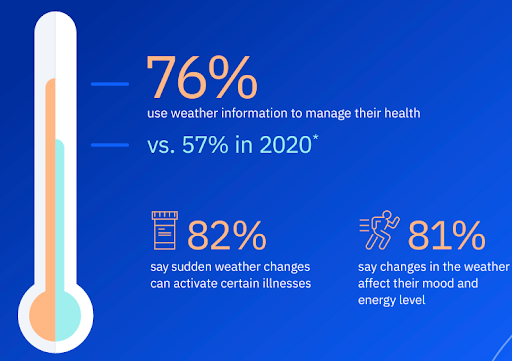
It only makes sense, then, for marketers to integrate weather data into marketing and media strategies. Weather data is a privacy-forward signal that offers businesses a predictive view of consumer behavior that can power the most holistic, contextual relevance.
Driving market share among qualified audiences
Weather Targeting equips and empowers healthcare marketers with trusted and synthesized weather and anonymized health data, placing brands in the direct path of qualified audiences and health decisions across the digital ecosystem.
Because we are The World’s Most Accurate Forecaster,3 brands and businesses trust The Weather Company as a valued partner. And since weather is pivotal for people’s daily health, so is accurate, comprehensive data in weather forecasting. We examine historical trends, current conditions, and future projections to provide accurate, relevant insights, and seasonal benchmarks. This information proves valuable for learning how weather impacts people’s activities, health, and purchasing decisions. But, it also helps us deliver cookie-less, hyperlocal ads that resonate with audiences, based around current and predicted weather effects on both symptoms and behaviors.
While the signals on their own can supercharge advertising and media targeting strategies, weather data is more powerful together with other synergistic data sources.
Take, for example, first-party audiences. By combining weather data with your first-party audience data and other diverse datasets, marketers can unlock a richer audience understanding that transcends the boundaries of individual data sources. This collaborative approach reveals insights that neither data source could discern alone, enabling marketers to connect with their audience across digital, physical, and emotional contexts with unparalleled relevance. In fact, according to Salesforce,4 only 31% of marketers are fully satisfied with their ability to unify customer data sources, limiting their ability to glean insights, plan campaigns, and sustain relevance across the customer journey.
Enhancing targeting through weather and data integrations
Health marketers are already starting to see the power of weather when combined with other targeting layers. For example, a leading pharmaceutical company wanted to increase awareness of, and prescriptions for, a specific diabetes prescription brand. Leveraging the insight that cold weather can exacerbate symptoms and drive a need for diabetes medications, CMI Media Group chose to harness real-time weather data from The Weather Company within Pulsepoint to anchor their campaign. Layering weather data onto an existing HCP target list, the brand was able to message the right HCPs when they’re most likely to consider appropriate pharmacologic therapy. This campaign showed significant impact, driving up the total number of prescriptions written in the impacted ZIP Codes. Results included:
greater CTR
lower cost per HCP reached
increase in HCPs for target areas who prescribed the brand
increase in total prescriptions written for the brand
Another recent data partnership that proved successful involved a type 2 diabetes prescription brand utilizing The Weather Company’s diabetes signals in The Trade Desk for programmatic advertising across various media platforms. The campaign was primarily measured through Crossix’s “Cost Per Unique Patient Reach,” which analyzed media exposure and its impact on diagnosed audiences, new prescriptions, and total prescriptions. The partnership proved so successful that the parent company launched a second type 2 diabetes brand using the same targeting strategy. A few results:
more efficient unique reach of qualified audiences on display compared vs. the brand’s average
more efficient unique reach of qualified audiences on video vs. the brand’s average
more efficient unique reach of qualified audiences on CTV vs. the brand’s average
Creating purposeful connections and better health outcomes
Weather’s impact on our day-to-day health and wellness decisions isn’t changing and successful marketers are taking notice. Weather signals are a trustworthy, innovative, and meaningful way to meet the needs of a healthcare marketing industry where personalization and privacy are paramount. Through Weather Targeting solutions from The Weather Company, you can connect contextually across physical, digital, and emotional realms to influence purchase decisions that support health and wellness goals. What’s your weather strategy?
Let’s talk
What’s your weather strategy? To learn more about harnessing the power of weather to increase engagement and drive growth, contact our advertising experts today.
Contact us1 The trends defining the $1.8 trillion global wellness market in 2024, McKinsey, January 16, 2024 Article
2 Weather & Health Impact Study, March 2024
3 ForecastWatch, Global and Regional Weather Forecast Accuracy Overview, 2017-2022, commissioned by The Weather Company
4 AI is Marketers’ Top Priority – And Biggest Headache, Salesforce, March 20, 2024 Article
While the 71st year of the Cannes Lions Festival of Creativity is officially in the rearview, the excitement and inspiration are still very much alive at The Weather Company. And right now, it’s clear the industry sits at a pivotal moment, with weather data and insights as key elements to its great potential.
From driving creative momentum, to bringing a renewed vigor and commitment to innovation and positive change, weather was a topic of many conversations, meetings, and thought leadership sessions. Our single takeaway: Weather data is no longer “nice to have” but a “must have” for understanding consumer behaviors and motivations, making more informed business decisions, and delivering action against our changing climate, for the back half of the year and beyond.
For some brands and businesses, a weather strategy may already be part of your broader marketing strategy; for others, it may be a new, innovative approach. Regardless of where you stand, here are three need-to-knows from this year’s Festival, brought to you by your Chief Weather Officer.
1) No cookies, no problem…for these brands

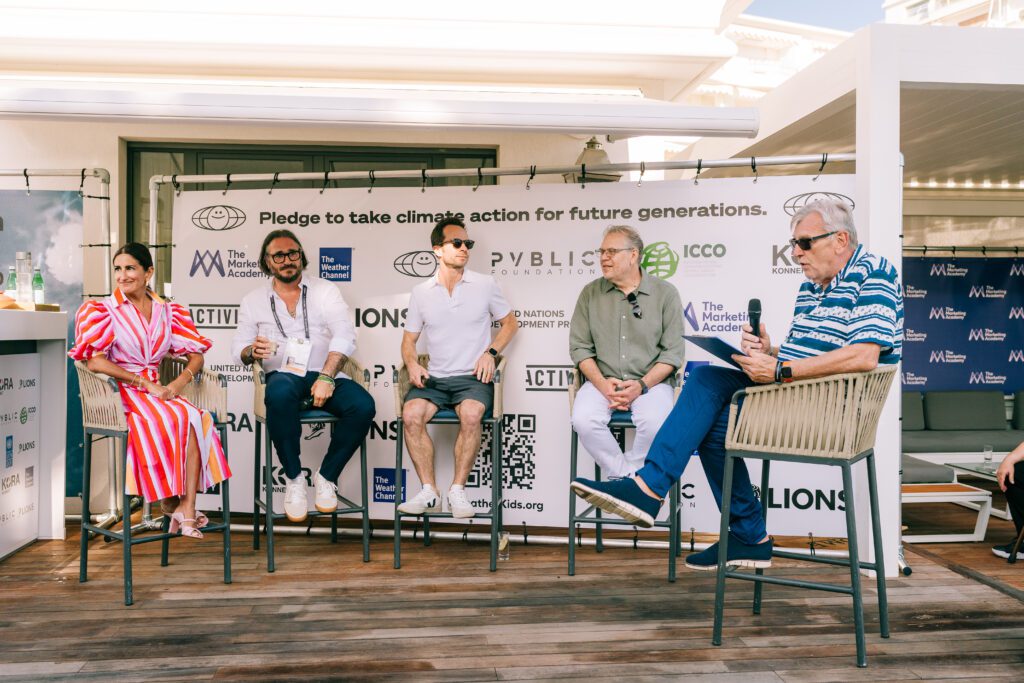
Randi Stipes, Chief Marketing Officer, at Little Black Book & Friends Beach and The Marketing Academy Villa stages
Data signal loss with cookies eventually going away has been an on-going topic in many Ad Tech circles and programming, and this year was no different. While the industry waits for cookies to fully deprecate, many brands and marketers are focused on defining their first party data and audience strategies, understanding clean room solutions, and adopting alternative privacy-forward data signals. Regardless of Google’s timeline, weather data has long served marketers in driving business growth while protecting consumer privacy.
This year, we partnered with four leading brands — Milk-Bone®, Chloraseptic, EcoFlow, and Tyson Foods — to showcase the value of a weather strategy. We call them the ‘Rainmakers of Marketing,’ smart brands that understand the deep connection between weather and consumer behaviors, moods, and motivations and are winning within their categories, in large part by leveraging weather to supercharge their campaigns. Our partnership with Milk-Bone, Chloraseptic, EcoFlow, and Tyson Foods were on display 24/7 across three digital out-of-home billboards along La Croisette (because Cannes Lions is the greatest opportunity to display OOH, of course). If you missed them, check them out here.
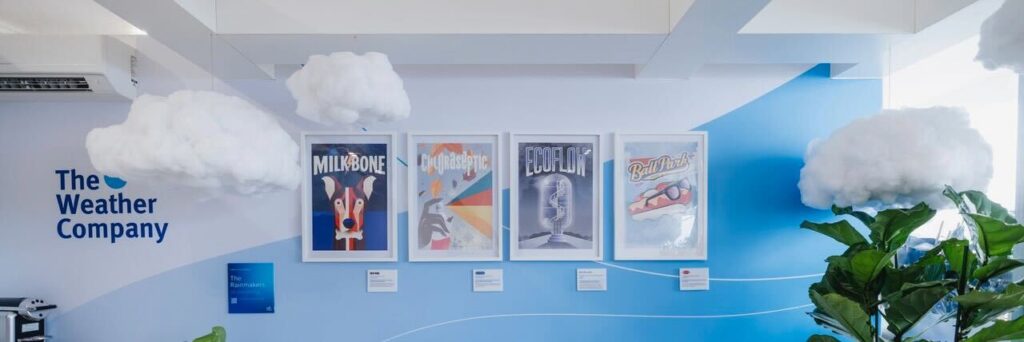
Rainmakers of Marketing poster art showcased in The Weather Company meeting suite at MediaLink Beach (L to R): Milk-Bone®, Chloraseptic, EcoFlow, and Tyson Foods


Sheri Bachstein, CEO, at The Haven x HUMAN and MediaLink Beach stages
2) AI: moving from conversations to commitments
Last year, the conversation around AI took on a very different look. Across the Festival mainstage and along La Croisette, creatives, agencies, brands, publishers, and creators were discussing AI’s advantages and disadvantages, debating how human creativity and thinking would play alongside the latest advancements and detailing how it would improve efficiency, performance, and outcomes across the advertising landscape. This year, those conversations shifted from ideation to application.
For The Weather Company, AI has long been foundational to our business. As the world’s most accurate forecaster,1 we combined AI, advanced weather science, and technology with human expertise to keep consumers informed, whether it’s how to dress for cooler-than-average temps at this year’s Festival or preparing for the most active Atlantic hurricane season (which is happening right now). Our deep expertise in AI doesn’t stop there. This June, we introduced the broader market to The Weather Engine™, a data and insights platform built on AI based multivariate models aimed to deliver deeper insights and visualizations on the impact of weather with zip code level precision. While there’s immediate benefit for advertisers when it comes to media activation and targeting, the real magic happens when we partner to create bespoke insights through the application or Machine Learning and AI against first party, third party, and other actionable data sets, specific for businesses and KPIs across advertising, marketing, and the entire enterprise.
Read how SC Johnson’s Off!® brand, America’s #1 trusted Insect Repellent brand in 2024, is finding success with The Weather Engine.

Cannes Lions Mainstage with Randi Stipes, Chief Marketing Officer
3) Weather: no longer small talk
From Sustainable Development Goal Lions, to reducing both waste and carbon emissions associated with the event, sustainability and climate continued as a core theme at this year’s event. The advertising industry, and the marketers behind the brands, sit in a unique position to shape public behavior and drive action, and that’s exactly why Cannes Lions was the perfect stage to proclaim the reality of changing weather and influence collective climate action — helping create connections between the weather and all aspects of human well-being.
We were honored to bring ‘Weather Kids,’ our joint campaign in partnership with the United Nations Development Program and the World Meteorological Organization, to the Cannes Lions mainstage. The conversation centered on a projected forecast for 2050, and how it might change depending on the climate actions we take today. Missed this session? If you have a Cannes Lions pass (physical or digital), you can watch it on demand, or read the ungated abridged version in the Cannes Lions Daily. Either way, be sure to take the two minute action of signing the pledge on behalf of the kids in your life to change the future for the next generation.
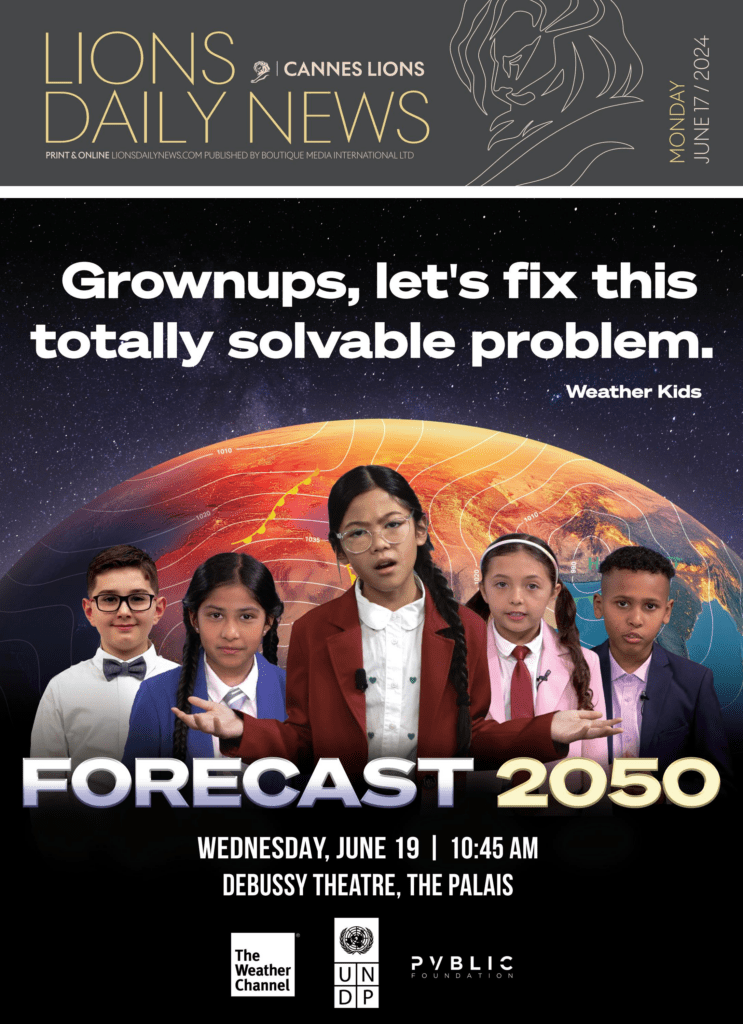
Cover image of Lions Daily News featuring ‘Weather Kids’ campaign
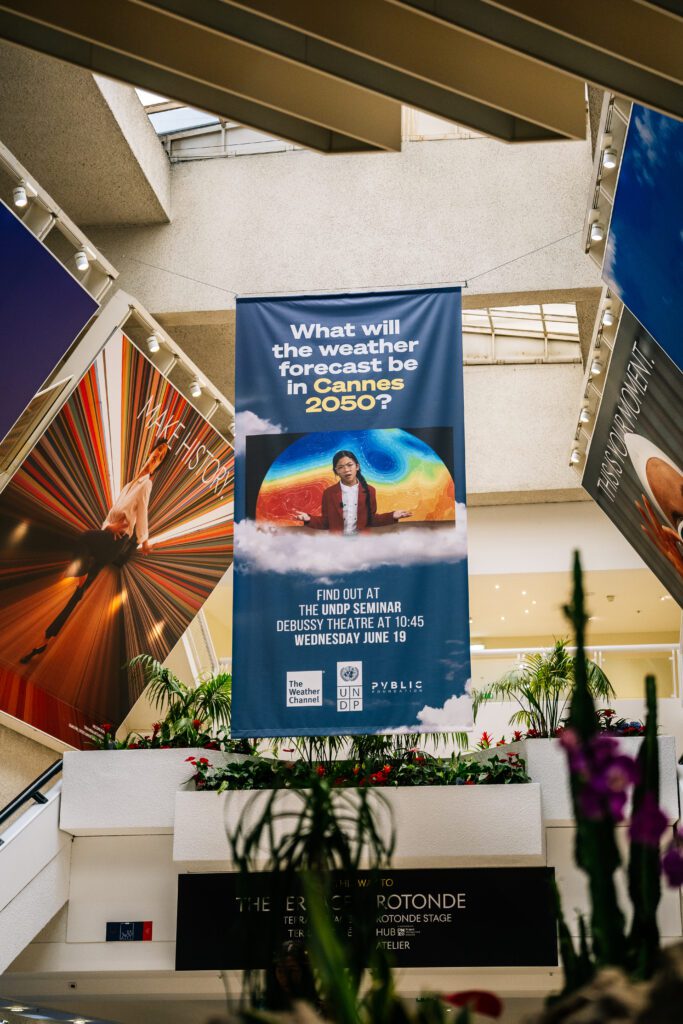
‘Weather Kids’ campaign banner hanging inside the Palais des festivals
Whether you attended the Festival or not, we’ll leave you with one final note, or perhaps action…
You either develop a weather strategy…or a strategy for defending why you didn’t develop a weather strategy. We’re here to help with the former.
Consider us your Chief Weather Officer.
Let’s talk
What’s your weather strategy? To learn more about harnessing the power of weather to increase engagement and drive growth, contact our advertising experts today.
Contact us1 ForecastWatch, Global and Regional Weather Forecast Accuracy Overview, 2017-2022, commissioned by The Weather Company
Editor’s Note: Welcome back to The Weather Company’s Forecast Multipliers series, where top marketing leaders share career advice, a POV on hot topics in their category, and how to build a successful weather strategy.
Durable. Reliable. Loyal fan base? STIHL Inc. is known for their outdoor power equipment, but also for their ongoing commitment to innovation and quality, making them a preferred choice for both pro landscapers and homeowners alike. But, it’s their approachable, community-driven, and informative social channels that keep the audience engaged — coming back for insights and advice, over and over again.
With over a decade of experience at STIHL Inc., Les Robinson is a seasoned social media and content management leader at the company. We met with Les to explore his career journey and hear his take on the evolving landscape of digital marketing. His narrative provides a compelling look into the world of social media and its transformative impact on marketing strategies and community engagement.
Turning personal passion into professional prowess
Les began his journey into social media years before mass adoption of today’s ubiquitous channels. In fact, he started his career in media, where he leveraged burgeoning online platforms to source stories for TV news. An early adopter of internet technologies, his knack for embracing what’s new paved the way for his transition into content management and ultimately led him to STIHL Inc. in 2011. “It’s been fascinating to watch social media evolve from an afterthought to a crucial marketing tool,” he shares. Another thing that connected Les to STIHL Inc.? His personal love for the brand. As a longtime user of their products, he notes that “walking through those doors everyday…it’s still pretty surreal to me.” He adds:
Fail quickly and keep moving forward
Reflecting on his long tenure in social media, Les underlines the importance of adaptability. “Things change, and that’s okay,” he says, noting the fast-paced nature of social media requires marketers to be flexible and open to learning what’s next. He adds, “When you embrace failure as a step towards success, the best ideas often emerge from a series of less successful attempts.” Marketers have to “be okay with that, adjust, adapt, and keep moving forward.” Here’s what he would have told himself thirteen years ago before beginning at STIHL Inc.:
Core values at the forefront of community
At STIHL Inc., Les’ role centers around not only building, but nurturing a community of loyal fans. “For me, it’s really about the community,” he explains. “I come to work every day and try to find ways to best serve them.” This community-centric approach is woven into the fabric of STIHL Inc.’s marketing strategy and identity, reflecting what the brand is known for: reliability, dependability, and power. Hear more on how STIHL Inc. connects their community and captures critical feedback through the power of social:
A match made in nature
One of Les’ key strategies: the use of weather data in marketing.
STIHL Inc., as an outdoor power equipment manufacturer, naturally looks to align marketing efforts with weather patterns. “Our product sales literally revolve around weather,” he notes. By partnering with The Weather Company, STIHL Inc. provides timely and relevant content to its customers, deepening their connection to the brand, by advising on storm preparation or suggesting the best time for DIY projects. Hear more on STIHL Inc.’s weather strategy:
Keeping it simple: Customers at the center
Two cornerstones of STIHL Inc.’s weather strategy are simplicity and customer focus. When it comes to leveraging weather, Les advises marketers to simplify their strategies — clear, easy-to-process content is more effective in achieving desired results. “If viewers have to spend too much time figuring out what the message is, they’ll just move on to something else.” He acknowledges simplicity can be challenging, especially when dealing with robust technology. “Convincing people that a basic idea is worth pursuing is one of the hardest things to do,” he admits. However, he believes simplicity in communication ensures that the message is received and the content serves its purpose, commenting:
Beyond simplicity, Les stresses the importance of keeping the customer at the center of all marketing efforts — weather-driven or not. “Figure out how your marketing strategy can benefit the end user versus just serving your purposes,” he advises. By starting with what the end-user needs from the brand or product, marketers can develop strategies that accomplish their goals while also serving the customers’ interests.
Memorable content is king
Les also reflects on the most impactful projects he’s worked on. He highlights “surprise and delight” initiatives aimed at rewarding loyal fans. “How do we surprise passionate fans in a way that they’ve never seen any brand surprise them?” he muses. This focus on creating memorable experiences underscores STIHL Inc.’s commitment to its community and its innovative approach to marketing.
Finally, Les speaks to what he views as the most valuable content STIHL Inc. creates – impactful content that serves both a business purpose and a community purpose:
Through all his insights, Les paints a picture of a dynamic and evolving field where adaptability, community focus, and innovative use of technology are strokes to success. Among other things, his journey at STIHL Inc. serves as a testament to the power of social media in creating strong, engaged communities and driving lasting business growth.
Let’s talk
What’s your weather strategy? To learn more about harnessing the power of weather to increase engagement and drive growth, contact our advertising experts today.
Contact usIt’s peak season in the south of France, a time when the region sees a population surge from local beachgoers and summer tourists alike. Meanwhile, the leaders of the advertising industry make their annual pilgrimage for a different reason entirely: the Cannes Lions International Festival of Creativity.
It’s an event where Mother Nature has taken center stage recently–delivering everything from high winds and rough seas, to a record-setting summer heatwave and unseasonal torrential rain. Weather influences nearly everything—your packing list chief among those things, perhaps, but if that’s the only thing weather is informing, respectfully, you’re doing it wrong.
Globally, weather is increasingly erratic and pervasive every year. As changing climate makes weather more volatile and impactful, every business needs a weather strategy rooted in weather intelligence. A smart weather strategy enables you to:
- Understand and predict consumer behavior with greater accuracy
- Mitigate risk and gain competitive advantage
- Gain efficiency across the enterprise
Through 40 years of weather science expertise, we’ve gained a deep understanding of consumer behavior, actions, and mindsets. And for marketers, that means we’re able to take that forecast data and derive insights to enable smarter, faster business decisions, for both marketing and enterprise-wide needs.
In this piece, you’ll find the weeklong forecast and more. We’ll delve into weather’s impact on the Festival, emerging trends, and anticipated highlights–including key sessions and speakers that, much like Mother Nature, are poised to make waves this year.


Cannes weather: Memorable moments, the 2024 forecast, and summer solstice
When it comes to outdoor events, weather can make or break the entire experience, and Cannes Lions is no exception. Weather plays a crucial role in influencing attendance–and inclement weather can certainly dampen spirits, reduce audience, and even lead to cancellations, while pleasant conditions multiply engagement and enjoyment.
In the last two two years alone, we’ve seen more extreme weather than is historically seasonal.
- 2022: A one-two punch of rain and heat
If you attended the Festival two years ago, you undoubtedly recall the three days of significant rain that fell in central Cannes and created a slew of challenges for outdoor venues and temporary festival builds along the beach. That same year, despite rain, temperatures soared to real-feel temperatures in the low 90s. The summers have been getting hotter and hotter recently in southern France, so the average maximum temperature is now 3.6-5.4°F higher than it was 30 years ago. - 2023: Strong winds and rough seas
Last year, it was high winds that sent weather reverberations across the Festival. Increased wave activity made for high swell that impacted yachting, and one particularly treacherous trip to Monaco made by sea (IYKYK). Out on the beach, gusts upended umbrellas and tore off temporary roofs on event spaces along the Croisette; public safety concerns like flying debris caused some venues to be forced to shut down temporarily.
Your 2024 forecast
Wondering what the memorable weather moment of 2024 will be? You’ve come to the right place.
So far in June this year, the hottest day was this past weekend on Saturday, June 8, reaching 88.52°F. There has been virtually no precipitation in Cannes so far in June. That warmth though was brief. May to June so far has seen cooler than normal temperatures at times where all the extreme heat has been concentrated over Southeastern Europe, reaching the 100s recently with 112.64°F recorded in Antalya in southern Turkey on June 6.
For the week of the festival in Cannes, we’re very unlikely to see any extreme heat. In fact, this year could be more like 2014 and the coolest for the past 10 years! Even still, given the unrelenting sun and countless trips up and down the Croisette, it’s bound to feel warmer. Sunscreen, hat, and comfortable shoes remain a must.
Will it rain? Maybe. Current forecasts suggest Wednesday, June 19, has a good chance of showers and maybe some thunderstorms. There’s greater uncertainty in the forecast Wednesday onwards as a sharp trough and low pressure moves west across western and central Europe. Our mets have high confidence Sunday to Tuesday will be fine but it’ll turn a lot more unstable from Wednesday. Since the weather system is moving from the west/northwest, Cannes is nicely sheltered so the shower and thunderstorm risks are lower than a little further inland and any showers should be isolated and Cannes just might miss them all together.
But should you pack an umbrella? Yes. There are signs a “wave” may develop over the western Mediterranean slowing the westerly progress a little, but resulting in a larger area of rain and thunder that may head across SE France and Cannes Thursday night to Friday. So, lots to watch out for later next week. Will Cannes escape dry or get a deluge? We’re hoping for the former. The middle to end of next week may see the highest wind gusts too, so some interesting weather to watch for out on the water.
While you’re on the ground, we’re bringing you the real-time forecast all week long from three digital billboards in the heart of the Festival. When you’re away from La Croisette, stay up to date with The Weather Channel app.
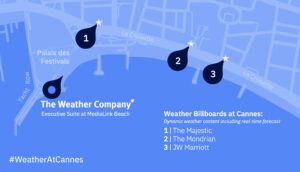

Summer solstice
While all days during the Festival feel long, Thursday, June 20, is indeed the longest day of the year. Summer solstice falls during Cannes Lions each year. The solstice, an astronomical event, coincides with a new meteorological season too: the start of summer. Since prehistory, the solstice has been a significant time of year in many cultures and has been marked by festivals and rituals. Many of these annual cultural festivities center not only on celebrating the sun’s light, but the light within people and belief in energetic shifts that reignite and inspire creativity. Pretty apropos!
Scientifically speaking, it’s when Earth’s axial tilt toward the sun is at a maximum point for the year, resulting in extended daylight and in turn…the longest day of the year. Practically speaking? We’re in for a sun-drenched Festival and some particularly majestic late-evening sunsets.
The broader forecast: What’s new and can’t-miss content
The Festival, too, is changing in tandem with our physical climate. Like our world, the broader advertising ecosystem is facing accelerative winds of change that, while predictable, are increasingly disruptive to the status quo. Amidst headwinds like the crumbling cookie and tailwinds like AI, make no mistake about it: the Festival is growing.
If you’re reading this, you’re very likely a Cannes veteran, so we’ll cut to the chase of some of the biggest changes you can anticipate this year:
- Yacht Row | Vieux-Port is partially under construction. Yacht Row remains open but with fewer berths–around 30 boats will host meetings and programming this year.
- A growing fringe footprint | Supplemental programming has exploded. The aggregate fringe program has been anecdotally reported at an estimated 700 satellite events this year.
- Year 2 of Brand Village | The new neighborhood on the official program has expanded in its sophomore year and moved inside the Festival perimeter, in a move to draw higher brand marketer attendance.
- The launch of LIONS Creators | As Creators become an increasingly important cohort for marketers, the festival has formalized a program to get them to Cannes. The 6th floor rooftop of the Palais will play host to ‘Creators HQ.’
Content forecast
Every year, a handful of themes reign supreme in the conversations held at Cannes Lions. Last year there was a single topic that permeated every discussion and sat indisputably in the top spot of every buzz list: AI.
But in Cannes annually in the third week of June, Mother Nature isn’t the only one blowing hot air. This year AI will retain its dominant share of Festival chatter, but we hope and expect to see the conversation progressed beyond nascent vision setting and hype, moving instead into the more pragmatic realm of the problems AI solves through to what implementation and adoption looks like for brands.
Other key topics include the influence of culture and creators, as well as sports and the opportunity for brands to tap into those engaged fandoms. Pressing topics like DEI and sustainability will get more practical and less performative. And finally, cookie deprecation and signal loss, as well as a larger conversation around consumer privacy concerns, will continue to loom large as marketers navigate the seismic paradigm shift in targeting.
At the end of the day, creativity will be the throughline of all programming, with an eye towards how it can power brands’ staying power and drive business growth amidst economic uncertainty.
Recognizing weather’s influence is only growing, these are your top, not-to-be-missed sessions:
On Leadership, Purpose & Values
MediaLink Daily Double Programming | MediaLink Beach
Monday, June 17 | 4:30 p.m.
Speakers:


What Will the Weather Forecast Be In Cannes in 2050?
Cannes Lions Mainstage | Debussy Theatre, The Palais
Wednesday, June 19 | 10:45-11:15 a.m.
Speakers:
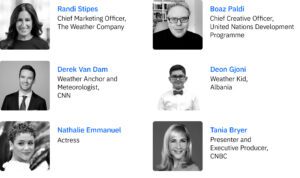

Key weather insights and tips: What to know to navigate the weather like a pro
The weather will likely impact your Festival experience, so here are some top tips to help you stay prepared and thrive–rain or shine.
1. Hydration
- Did you know? Our bodies are about 60% water, and heat amplifies how quickly we lose that water through breathing and sweating. You can lose up to half a gallon of water in a couple of hours in very hot conditions, and dehydration can occur in as little as 30 minutes. 59% of health-minded consumers use weather information to increase hydration as a preventative measure to manage their health condition or symptoms (Source: Weather and Health Impact Study, March 2024), as dehydration can exacerbate chronic pain and headaches.
- Pro tip: Target drinking a gallon of water a day in hot temps, especially if you’re indulging in the rosé which flows throughout the festival. Just like the heat, alcohol can also accelerate dehydration. Pack a reusable or recyclable water bottle; you’ll find water refill stations throughout the event.
2. Humidity
- Did you know? In combination with hot temps, increased humidity makes it harder to cool off because the body does so through the evaporation of sweat, which is hindered in muggy conditions.
- Pro tip: Wear lightweight, breathable fabrics in light-colored hues. Choose fabrics like cotton, linen, and moisture-wicking synthetics that allow your skin to breathe and moisture to evaporate. Light-colored clothing reflects sunlight rather than absorbing it, which helps keep you cooler.
3. Sun exposure
- Did you know? In June, the average high temperature is 74.8°F, but the French Riviera sun is especially strong. In France, climate change has caused some of the greatest annual temperature increases registered in any country in Europe.
- Pro tip: As you traverse the Croisette multiple times a day, and sit for your outdoor meetings, sun protection is especially key. Wear sunscreen, and don’t forget to reapply throughout the day. While any sunscreen is superior to none at all, you may want to procure your SPF from a local French pharmacy. Sunscreens available in the EU are often considered superior to those in the United States due to stricter regulations and more advanced formulations. The EU has approved a wider range of UV filters, allowing for more effective and broad-spectrum protection. Speaking of, a hat for personal shade adds another layer of protection!
4. Sleep
- Did you know? Achieving the ideal sleep state requires lowering both core and brain temperatures by approximately 2-3°F. In higher temperatures, melatonin production that induces sleep is disrupted (Source: Healthline). Individual preferences vary, but the optimal temperature for sleep is 65°F.
- Pro tip: This can be tough to accomplish as, depending on your accommodations, air conditioning that allows for precise climate control isn’t the norm in the South of France. Open your windows to let in the overnight Riviera breeze, or pack a small fan or cooling eye mask–you’ll fall asleep faster and have a more restful slumber.
Stay in the know. Much like our industry, the forecast is increasingly dynamic. Be sure to download and regularly check The Weather Channel app for the very latest forecast to help you navigate the week in Cannes.
Travel safe and we’ll see you soon,
The Weather Company
Consider us your Chief Weather Officer
Let’s connect in Cannes
What’s your weather strategy? To learn more about harnessing the power of weather to increase engagement and drive growth, schedule time to meet with a member of our leadership team on the ground.
Request a meetingEditor’s Note: Welcome to the first installment of The Weather Company’s Forecast Multipliers series, where top marketing leaders share career advice, a POV on hot topics in their category, and how to build a successful weather strategy.
When you think of e.l.f., what comes to mind? Perhaps it’s their accessible, often viral products for every eye, lip and face. Or, maybe you envy their relevance with Gen Z, fueled by witty social campaigns like the recent collaboration with buzzy brands and celebs like Liquid Death or Jennifer Coolidge (#dolphinskin).
However e.l.f. pops for you, one thing is clear: they’ve figured some things out in the marketing department. We sat down with Patrick O’Keefe, VP of Integrated Marketing Communications, for a candid conversation on his career and time at the cosmetics leader. Leading a dynamic team in paid, earned, and owned media, as well as immersive, experiential, and entertainment marketing, Patrick’s journey is filled with unexpected turns and rich experiences, offering valuable insights into the beauty industry and beyond.
From Mickey to military
Patrick’s professional journey began with a Disney internship, which profoundly influenced his career path. This whimsical start quickly shifted when he enlisted in the Air Force. From there, Patrick’s career took another turn when he joined association management firm, Smith Bucklin and Associates, which ultimately introduced him to the beauty industry. His next stops at Ketchum PR and major beauty brands like L’Oréal (14 years) and Shiseido (7 years) further honed his expertise, eventually leading him to e.l.f. We asked Patrick if he had any career advice. Here’s what he had to say:
Showing up and connecting deeper
Patrick emphasized that community is at the heart of e.l.f.’s marketing strategy. He explains, “We listen, we learn, and we lean in.” Clearly, it pays off: this approach has driven the success of numerous campaigns, including the launch of their Bronzing Drops and the Jelly Pop line. Hear more on what Patrick describes as “the center of our universe”:
By engaging with the community at every level, from TikTok Lives with the CEO to crowd-sourcing product feedback via creators, e.l.f. has fostered a deep connection with its audience. Patrick shared a few examples of bringing products to life with the help of their loyal community:
Taking big swings
Chances are, you’ve noticed e.l.f.’s uncanny knack for tapping into the cultural zeitgeist. The brand is known for its bold marketing strategies that start with an insight and scale through unexpected partnerships—like their recent Super Bowl commercial with Jennifer Coolidge that boosted e.l.f.’s Power Grip Primer to the top SKU in mass beauty. But it’s not just trial and error driving their approach; it’s taking calculated risks that stay true to the brand’s ethos of inclusivity and empowerment, every time. Patrick weighed in on the campaign:
Insights equal disruption
Another standout campaign from e.l.f. near and dear to our hearts: the hilarious “Glow Storm” campaign starring Meghan Trainor that leveraged weather as the insight that started it all. It resonated deeply with consumers, generating 5.7 billion PR impressions by leaning into humor and narrative-driven storytelling. Patrick shares how it came to life through an insights-driven marketing approach and how weather supercharged the campaign:
In fact, Patrick found the insights so powerful, they’ve changed his conversation with every agency on marketing efforts going forward:
Words of wisdom
Patrick is not only passionate about the work e.l.f. does, but also the values they stand for. “It all starts with a framework. We’re bold disruptors with a kind heart. We disrupt norms, we shape culture, and we connect communities… That’s the framework in which we operate everything we do, including people we hire. Whomever we work with has to be part of the spirit of the e.l.f. ethos,” he adds.
Patrick’s journey from Disney intern to marketing leader at e.l.f. underscores the importance of flexibility, lifelong learning, and the power of leaning into community-centric marketing. We can’t wait to see how e.l.f. continues to innovate, inspire, and connect with audiences. Patrick is eager to keep on showing us.
Let’s talk
What’s your weather strategy? To learn more about harnessing the power of weather to increase engagement and drive growth, contact our advertising experts today.
Contact usEditor’s note: In March 2024, we conducted a Severe Weather Consumer Behavior Survey of The Weather Channel app users. Here are our data-rich findings and valuable insights for marketers.
Hurricane season is right around the corner and the forecast calls for one of the most active on record, with almost double the amount of named storms. It’s hard to ignore the increasing severity and volatility of weather. In fact, 63% of people surveyed believe weather is becoming more severe or unpredictable. And while more devastation is likely to come, a staggering 9 out of 10 of respondents have already personally felt the effects of severe weather in the past two years.
So, how do we prepare for, or–more importantly–recover from, the seemingly inevitable impact of extreme weather events?
We don’t have to go it alone and–the good news for marketers–consumers don’t want to. People turn to brands, products, and services they trust the most ahead of, during, and after severe weather events. Which gives marketers across retail, CPG, energy, health, insurance, travel, and more, an invitation to show up with empathy, authenticity, and support when it matters most.
The far-reaching effects of severe weather
The impact of severe weather is sweeping, significantly touching many aspects of people’s lives. Where does your brand see itself in this picture?
Physical surroundings
Starting with perhaps the most obvious impact, severe weather can wreak havoc on the physical things in our lives. In fact, 80% of people report facing physical challenges of some kind when it comes to severe weather, notably the safety of their home, loss of gas or heat, and diminished air quality.
Mental health
The toll on mental health due to severe weather is also very real. The fear of being in harm’s way, experiencing property damage, or having a disruption in plans or routines can be incredibly stressful, with 40% of those surveyed reporting heightened anxiety. This increased stress affects all generations, especially younger ones.
Decision-making
Severe weather influences obvious things like travel plans. But it can also come into play when choosing a vehicle to drive or exploring home energy options. The data speaks for itself–84% of people admit weather plays a role in their decision-making process. Particularly striking is the number considering relocation due to severe weather events: 1 in 4 have considered, or would consider, moving because of severe weather events.
Preparing for severe weather
We have entered an era where severe weather can happen pretty much anytime and anywhere. We don’t have to look too far in the rear view to recall the raging Canadian wildfires, uncharacteristic twisters in the upper midwest, and Los Angeles blizzard warnings. Our respondents also reported an increase in both the number of severe weather events and unusual activity for their location/season. This means seasonal preparedness is an always-on activity, with consumers seeking trusted guidance and solutions year round.
Staying informed
As a result, checking the weather has become second nature: 99% check the weather more often when severe weather is forecasted, up 18% since 2021. For most, it’s to ensure safety for themselves, friends and family, while others are simply interested in the science of severe weather phenomena.
When it comes to critical safety and preparedness information, people rely on weather websites and apps above all other media sources, including government alerts:
- 88% rely on weather websites or apps the most, vs other media sources (#1 response).
- The Weather Channel is the leading weather provider, with 90% of respondents indicating they rely on the Weather Channel for accurate severe weather information (#1 response).
Stocking up and charging up
We’ve all been there, faced with rapidly emptying shelves of supplies and essentials as severe weather approaches. Meanwhile, the ultra-prepared plan ahead with fully-stocked emergency kits of non-perishables, flashlights, batteries, and first aid. Whether proactive or reactive, the most common preparation behaviors reported range from stocking up on supplies like groceries, medication, and air purifiers; preparing back-up energy sources; and securing a home, yard, or car.
Brands can authentically help customers weather the storm
It’s a sensitive topic, for sure. Brands may feel uncertain about how to engage when people are in some of their most anxiety-filled, vulnerable moments. When actually, they’re expected to intervene and provide assistance, whether it’s offering preparedness tips or essential supplies like medication, power and groceries. Not to mention, 94% also expect brands to step up to help communities affected by severe weather events.
TruFuel’s full-funnel lift and engagement
TruFuel, a maker of pre-packaged precision-engineered, outdoor equipment fuel harnessed the power of a weather-driven strategy in 2023. Tapping into their authentic desire to help consumers be prepared for severe weather conditions and outcomes, TruFuel dynamically aligned messaging with real-time, local weather conditions.
Activated across The Weather Channel properties and digital ecosystem through Adform, this targeted, contextual messaging helped highlight the importance of keeping generators, chainsaws, snowblowers, and other equipment ready for when severe weather strikes. And, also resulted in benefits for the brand, including:
- 5% lift in aided awareness
- 7% lift in favorability and purchase intent
- 8% lift in familiarity
Secure your weather strategy
Brands can play a crucial role–and earn priceless brand trust in the process–by providing resources and support to address the physical, emotional, and lifestyle concerns caused by severe weather. With a portfolio of advertising solutions, we can help you deliver the right, empathetic message, in the right place, at the right time:
- Leverage Weather Targeting to integrate your preparedness message across the digital ecosystem
- Align your brand with seasonal and severe preparedness content on The Weather Channel to help consumers stay safe and informed
- Drive awareness with exclusive, native CTV content integration in the LG home screen when there is an active National Weather Service (NWS) alert in the viewers’ local area
Severe weather is a reality we can’t ignore. But with it comes the chance for brands to help consumers navigate this reality, with preparedness before, support during, and resilience after the storm. Will your brand be there when consumers need you most?
Let’s talk
What’s your weather strategy? To learn more about harnessing the power of weather to increase engagement and drive growth, contact our advertising experts today.
Contact usSince waiting for Google to deprecate the third-party cookie feels a bit like waiting for a watched pot of water to boil, visionary marketers are already capitalizing on the renaissance of contextual advertising to supercharge their strategies.
But let’s start with some… context.
Since 1994, third-party cookies have used basic technology to fuel just as basic personalization, but they lacked the dimension that allowed marketers to achieve precision and deep connection. As technology has advanced, consumers are increasingly wary of the overuse of data to make up for the limits of cookies:
- Almost half (46%) of consumers worldwide think promotions based on their activity within 2 minutes of visiting a website or app is “creepy,” according to a Marigold and Econsultancy survey.
- A poll of social media users by social justice organization Global Witness and YouGov found that 57% of people said, “I don’t want my personal data being used to target me with any ads, either commercial or political.”
Now, marketers are excited to re-focus their data strategies toward a more privacy-friendly and human-first approach.
One strategy that’s very much a part of that future ecosystem is the legacy solution of contextual targeting, given its ability to personalize relevant media messages without cookies. But to truly be innovative, we need to broaden the definition of contextual targeting’s capabilities and how effective it can be.
Contextual targeting in 2024 has the potential to be so much more visionary than activating media tied to simply a few words on a page. It’s emotional, it’s environmental, it’s personal–not to mention, it’s effective.
When contextual targeting is used to its full capacity, it supercharges smarter advertising decisions, influencing and reflecting media consumption according to a person’s physical environment and emotional state.
But how exactly can marketers use data to better connect to a person’s state of mind? And even more, how do they reach people in real-time when they are making those emotionally-driven decisions? Enter weather data.
Weather data is the ultimate contextual accelerant
Weather is a hyper-local signal that influences every aspect and decision—consciously or not—of people’s lives. It influences how we feel, what we do, where we go, and what we buy.
Advertisers have long used weather data to target specific products based on changing conditions. Think of a coffee brand switching beverage messages from warm to cold as the seasons change, or a cruise line showcasing images of warm locales in the depths of winter. Think of yourself lounging poolside with the sun shining based on the weather forecast–sounds nice, right?
While all great, effective, and somewhat obvious use cases, weather data presents a more nuanced and much deeper understanding of the consumer with a holistic, multilayered view that goes far beyond surface-level transactions. With The Weather Company’s Weather Targeting suite of signals, brands are tapping into a much more inspired set of data and use cases that are richer and more privacy-friendly cookie alternatives.
Here’s why:
- Contextual weather data enables rigorous privacy and ethical standards while still achieving scalable precision. The unique combination of proprietary and NVIDIA AI-based technologies along with deep expertise from over 100 meteorologists allow us to deliver the most accurate and trusted weather data. That combination is one of the reasons that ForecastWatch, the only globally recognized measure of forecast accuracy, named us The Most Accurate Forecaster1, 3 times more likely to deliver an accurate forecast than our closest competitor. In addition, our consumer brand, The Weather Channel, was named a Top 10 Most Trusted brand.2
- Weather data presents a more nuanced and deeper understanding of the consumer. That’s because weather information not only reaches people during specific conditions, but also when they’re in the right mindset; often when they are motivated to do something. Consider the national department store that recently tapped into weather signals to predict when consumers needed retail therapy (due to lousy weather), or when they were feeling optimistic and eager to spend (sunny, bright skies brightened the “outlook,” in more ways than one). That retailer saw a 26% incremental jump in foot traffic by tapping into those signals.
- Weather data can help drive timely demand. With a personalized message at the right time, precise weather insights motivate behavior and drive action–within seconds of the message being seen. For example, a travel bureau recently activated messaging to consumers in snowy climates with invitations to warm escapes, generating a 57% surge in time spent on the bureau’s site when those blustery conditions made them crave being anywhere else.
- Weather information can predict utility, ultimately increasing brand preference. TruFuel, a premixed fuel product that powers outdoor equipment, leveraged the connection between weather and power equipment to engage people ahead of severe weather in their area. Knowing that 54% of people look to brands for tips and solutions around electricity and/or portable power solutions during inclement weather, TruFuel activated contextually relevant creative. The intelligent creative aligned generator messaging with a person’s real-time weather conditions, resulting in a CTR 8 times higher and a 7% lift in purchase intent.
With the right signals, contextual targeting is evolving into a dynamic and lasting solution for performant media strategies. Brands, like the ones above, are able to achieve holistic relevance that drives action, all while respecting the privacy of their customers.
As the advertising industry nears the end of one era and the beginning of another, the call for strategic and innovative signals like weather data is at an all-time high, and the opportunity is ripe for marketers to be first movers in setting the tone.
Sunny skies ahead, indeed.
Let’s talk
What’s your weather strategy? To learn more about harnessing the power of weather to increase engagement and drive growth, contact our advertising experts today.
Contact us1 ForecastWatch, Global and Regional Weather Forecast Accuracy Overview, 2017-2022, commissioned by The Weather Company
2 According to a Morning Consult May 2023 survey: The Weather Channel brand was the #9 most trusted brand in the US. The surveys were conducted from 3/3/2023 through 4/3/2023, among a nationally representative sample of 799 to 8,434 U.S. adults.
Sunrise to sunrise, weather influences our lives every day. For some, the weather determines if they can work outside or the best time to go for a run. For others, the weather affects how they manage their seasonal affective disorder or when to stock up on allergy medication. Checking the weather forecast isn’t just a daily habit, it’s a life habit.
As the world’s most accurate forecaster overall,1 we have a front-row seat to how changing weather is impacting consumers’ lives. Tornado alley has widened2, allergy “season” is longer3, and daily high-temperature records continue to be broken4. In fact, did you know that 2023 was the earth’s warmest year on record?5 As a result, consumer needs are changing and the utility of weather in our lives needs to reflect these realities. We knew we must provide more to our 360 million+ average global monthly users.6
A tool for more than just every day—but every lifestyle
Together, with input from our audience, we set out to reimagine a weather experience that better anticipates users’ needs and delivers personalized insights in the moments that matter—from informing consumers about conditions that can affect breathing in their area to how to maximize time outdoors. Our ambition? To create a seamless, intuitive user experience, getting people what they need quickly within a modernized design that is as inspiring as it is functional.
We re-examined the tone of our experience as well. More than 80% of surveyed respondents reported they agreed that weather influences their moods and emotions, and 67% noted that weather impacts their physical health.7 While we will always prioritize safety during severe weather moments, we felt compelled to surface moments of good as well. Not only telling customers that it’s going to rain, but also when their next sunny day is. We wanted to offer more of a balance between critical severe weather information and insights into how weather can impact their passion points like wellness, travel, pets, gardening and more. Ultimately giving people information to help them live smarter and happier lives.
This approach created a distinct challenge—in which we needed to personalize an individual’s unique, hyperlocal interests and must-haves, while simultaneously being a trusted resource for more than 45 million daily visitors who visit our digital properties, on average8. Especially for our mobile app audience who visits an average of 28 times a month9. Solving this issue wouldn’t be possible without our combination of data with AI technology to quickly determine the most impactful information.
Basic weather data continues to proliferate. Thanks to the increased accessibility of AI, we’re seeing more businesses enter the weather sector. But not all weather providers are created equal—that’s where The Weather Company’s decades of meteorological expertise, deep understanding of consumer behavior, and data-science proficiency in uncovering insights pay off. In a world where seasonal norms are being upended and many consumers prioritizing their wellness10, accuracy and trust have never mattered more.
The intersection of consumer and marketer needs
Weather isn’t the only changing element. We’re all experiencing the unique transformation underway in marketing and media, one that aims to consider consumers’ privacy—a shift I applaud. Weather, as a digital consumer experience and data signal, provides marketers with contextual, timely and privacy-forward data that is necessary to navigate this new advertising paradigm.
While reimagining our consumer weather experience, we thought hard about the unique intersection we occupy between consumers and marketers. This app creates spaces for more storytelling freedom, a canvas that enables marketers to align their stories with the unique, weather-related needs of millions of consumers.
We focused on elevating and modernizing our advertising integrations that contextualize a brand’s message to specific consumer needs. Whether it’s capturing the first impression of the day as users are in a planning mindset with our Integrated Marquee or creating a deeper connection through wellness experiences like our Allergy Forecast, every integration is built from a consumer-first perspective.
Welcome to The Weather Channel’s fully reengineered flagship app
As we all look to the future, cookieless targeting solutions will only increase in importance. Given the reach and frequency of The Weather Channel digital properties, and its recognition as one of America’s most trusted brands,11 our suite of data-targeting solutions is designed to help mitigate the risk many brands are up against. From a robust weather-targeting suite to contextual signals like health or travel and first-party audiences like pet owners, parents and new homeowners, our goal is to help marketers succeed in the short-term and long-term.
We can’t escape the changing atmosphere of our earth or our industry. Keeping pace with the weather means keeping pace with consumer needs at any given moment. The relaunch of The Weather Channel app is the first evolution of an engaging experience that can empower people to thrive amidst increasingly volatile weather, and propels brands to succeed within a shifting advertising landscape.
We welcome you to experience the next chapter of weather with us and enjoy the next sunny day to its fullest. Download the new app for iOS in the Apple App Store and Android later this year.
It’s Dynamic. Bold. Personal. I’d love to hear if you feel the same.
To learn more, visit our press release.
1 ForecastWatch, Global and Regional Weather Forecast Accuracy Overview, 2017-2022, commissioned by The Weather Company
2 Fischetti e alt, “Watch Out: Tornado Alley Is Migrating Eastwar”, May 11, 2023
3 ”Yes, Allergy Seasons Are Getting Worse. Blame Climate Change”, May 23, 2023
4 “US, Europe Heat Records Smashed This Summer”, The Weather Channel, August 2, 2023
5 Jonathan Erdman, “It’s Official: 2023 Was The Earth’s Warmest Year On Record”, January 9, 2024
6 Based on the average of the total monthly (non-unique) users for January – June 2023 across The Weather Company digital properties and consumer products (weather.com, The Weather Channel app, Weather Underground app, wunderground.com, Storm iOS app), according to The Weather Company internal data
7 Harmony Bay Wellness: ‘The Effect of Weather on Your Mood’, Leading global management consulting study, March 2023 n=1,993
8 Based on the average of global daily unique visitors monthly for February – July 2023 across The Weather Company digital properties and consumer products (weather.com, The Weather Channel app, Weather Underground app, wunderground.com, Storm iOS app), according to The Weather Company internal data
9 Based on the average global app monthly visits / global monthly unique visitors for January 2023 – August 2023 across The Weather Company App Properties, including The Weather Channel and Weather Underground, according to The Weather Company internal data
10 The Weather Company AI Health & Weather Impact study, August 2020
11 Named one of 2023’s most trusted brands by Morning Consult, May 2023
The Weather Channel brand was the #9 most trusted brand in the US. The surveys were conducted from 3/3/2023 through 4/3/2023, among a nationally representative sample of 799 to 8,434 U.S. adults. Also named most trustworthy media organization in an April 2023 poll by YouGov: Linley Sanders, “Trust in Media 2023: What news outlets do Americans trust most for information?”, YouGov, May 8, 2023.

